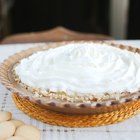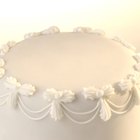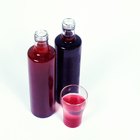
If you love to bake, you are likely to encounter recipes calling for one of two varieties of homemade custard. Unlike the mixture appearing in American cuisine as cup-custard and in French as creme caramel, creme Anglaise and pastry cream are custards designed to be blended with other dessert ingredients. Both add a smooth, creamy quality to fruit and pastry sweets but neither can be substituted for the other.
Creme Anglais
This English dessert staple is made by heating light cream or half-and-half with vanilla, stirring it into egg yolks beaten with sugar, then slowly blending all ingredients over heat until the mixture has a thick, sauce-like consistency. Cooking the egg yolks too quickly is the main hazard of making creme Anglaise, which can can curdle if heated above 180 degrees Fahrenheit. Allow four to five minutes of steady stirring to thicken the custard, then strain it through a fine strainer or cheese-cloth-lined coarse mesh strainer. Some cooks set a bowl in an ice bath to prevent continued cooking of the strained custard. Cooks with less patience make creme Anglaise from commercial mixes found at specialty stores.
Cooking with Creme Anglaise
Creme Anglaise is a thick, pourable sauce, commonly referred to simply as custard in the British Isles. Homemakers top fresh or canned fruit with creme Anglaise as a family dessert, just as American cooks might use ice cream, yogurt or whipped topping. Creme Anglaise also makes an excellent topping for dense, unfrosted cakes like pound cake. This is the kind of custard called for in recipes for trifle, which is a pudding created from pieces of sponge cake, fresh and preserved fruit, custard and sometimes a liqueur.
Pastry Cream
Pastry cream, or creme patissiere, is customarily made with milk, not cream. Cornstarch or a mixture of cornstarch and flour is added to produce a thick custard that can be used as a filling for pies, cakes, cream puffs and eclairs. Its spoonable consistency means it can also be served in a bowl as a pudding dessert. Pastry cream is classically flavored with vanilla but can be created in chocolate, coffee, lemon and other flavors as well. While pastry cream, like creme Anglaise, can be damaged by overcooking, it is important to bring milk to a boil, activating the thickening capacities of the cornstarch or flour. Pastry cream does not need to be strained, but the top should be covered with plastic wrap to prevent formation of a top skin as it cools.
Using Pastry Cream
Use pastry cream, with or without added flavorings as a quick pie filling. Spread it between cake layers to create a boston cream pie. Split cream puffs or eclairs and fill them with pastry cream. Some cooks mix pastry cream with an equal quantity of whipped cream, then fill pastries from a pastry bag. Spread between sheets of puff pastry, pastry cream lets you make showy Napoleons. Alternate cream layers with jam or jelly ones for your own special take on this festive confection.
Related Articles

How to Fix Grainy Whipped Ganache

Custard vs. Pastry Cream

How to Harden Up Whipped Cream

How to Make Creme Brulee Without a Torch

How to Use Granulated Sugar for Frosting

How to Make Easy Pudding Pie

How Long in Advance Can You Cook Creme ...

How to Boil Blackberries & Sugar for a ...

How to Make a White Decorator Icing

How to Puree Peaches

Sugar-Free Coconut Cream Pie

Can You Use Heavy Cream When Making ...

How to Prepare Peaches to Make Peach Pie

How to Fix Runny Boston Cream Filling
3 Easy Bundt Cake Recipes

How to Thicken Cream Filling

Tapioca Flour Vs. Quick Cooking Tapioca

How to Make Sweet Syrup With Fruit Juice

List of French Pastries

Different Types of Whipping Cream
References
Writer Bio
Janet Beal has written for various websites, covering a variety of topics, including gardening, home, child development and cultural issues. Her work has appeared on early childhood education and consumer education websites. She has a Bachelor of Arts in English from Harvard University and a Master of Science in early childhood education from the College of New Rochelle.
Photo Credits
Jupiterimages/Comstock/Getty Images